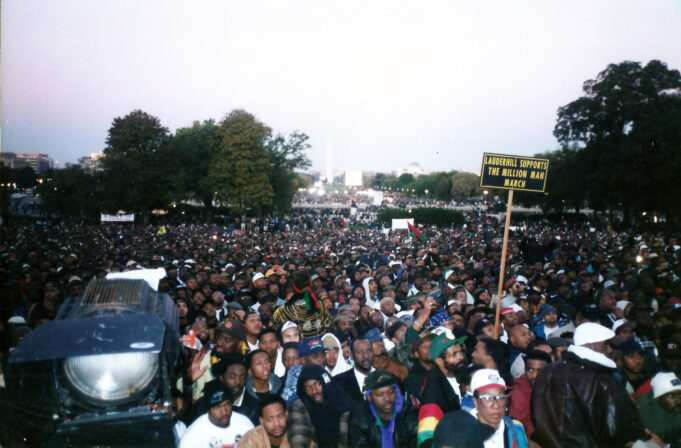There is no question history was made October 16, 1995 when nearly two million Black men gathered on the National Mall in Washington D.C., for the Million Man March. This year 2020, the “glimpse of heaven,” as some described the day, marks its 25th anniversary.
The march was convened by the Honorable Minister Louis Farrakhan of the Nation of Islam and brought together a plethora of people and organizations from across the Black experience who organized and mobilized to make the day happen.
The seed of the Million Man March can be attributed to a discussion between Minister Farrakhan and his teacher, the Most Honorable Elijah Muhammad, about the 1963 “March on Washington for Jobs and Freedom,” held by the major civil rights leaders of the time. During the course of his talk, the Honorable Elijah Muhammad was critical of the spirit of frivolity and fun at the event and lack of the serious demeanor for a march for jobs and justice. He told Minister Farrakhan, “One day I’m going to lead a march Brother” and “we won’t leave Washington until we get what we go for and that is justice.” Minister Farrakhan has said the comments were embedded in him.
In later years, the Minister came to see that the United States government had embarked on a war on Black people under the pretext of fighting a war on drugs and gangs. The condition of Black life in the 1990s leading up to the march played a large part in calling for it.
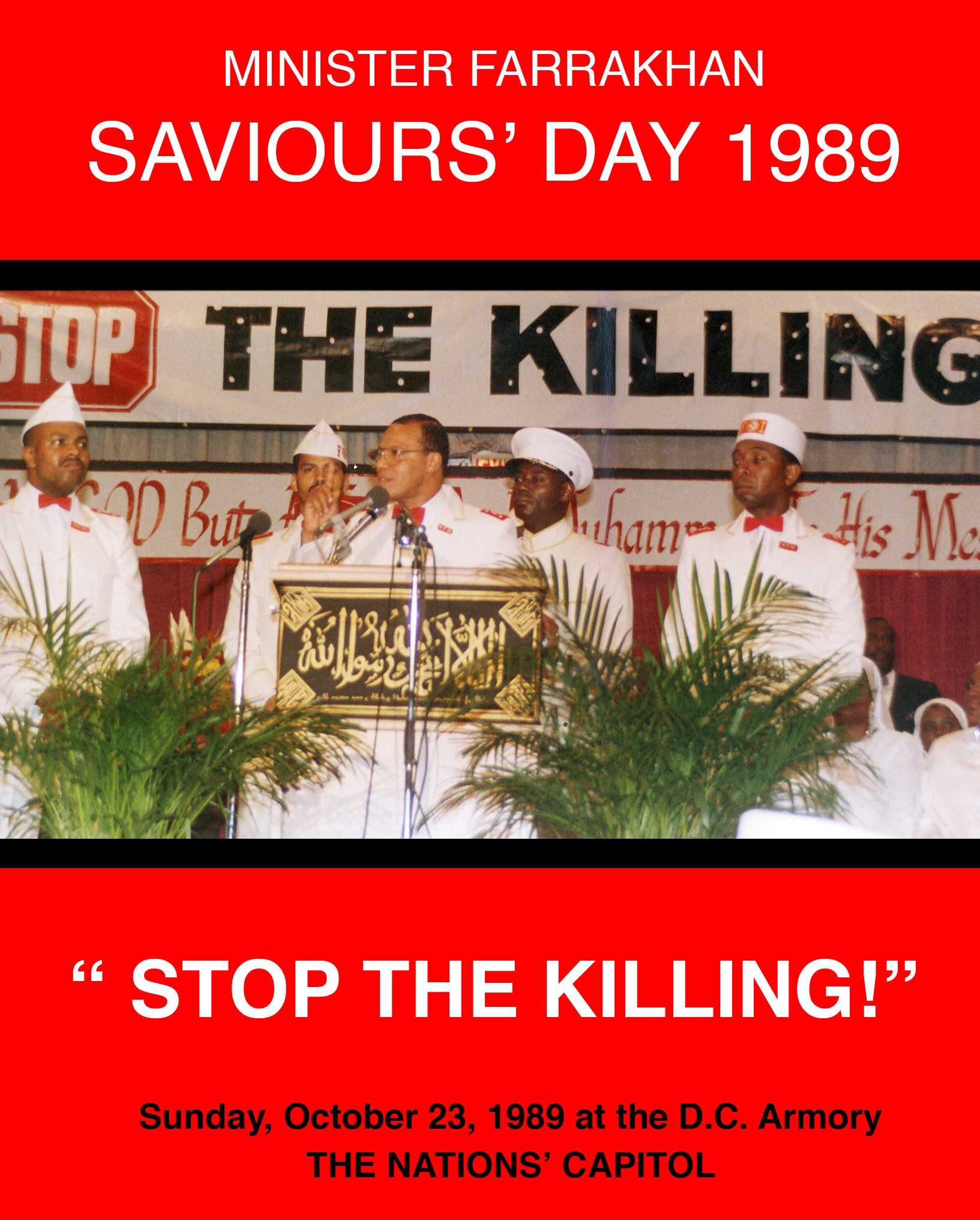
The Minister responded by going on a “Stop the Killing” tour where he spoke out against the fratricidal actions permeating Black communities of America.
He saw how the stage was being set against Black people, but men in particular.
There were negative images of Black men as savage, uncivilized, berserk, beasts and used Hollywood movies of the time such as “Boyz in the Hood” and “Menace II Society” which were mass marketed worldwide.
It was during the Stop the Killing tours in New York City, that he raised another initiative to hold “Men Only” meetings throughout the country. He came to New York January 24, 1994, as the first city on the tour. Some 20,000 Black men lined the streets to hear Minister Farrakhan at the 369th Armory in Harlem. That night, Minister Farrakhan first stated his desire to take one million Black men to Washington, DC.
“When the word went out of my mouth,” Minister Farrakhan said later in interviews, “I watched it go out of my mouth … and I had to go catch the words.” He began organizing and planning to make it a reality.
From New York, he spoke in other cities like Washington, D.C., to over 14,000 men; Atlanta drew 19,000 men; Houston drew 35,000 and huge crowds turned up everywhere he went. The lead up to the Million Man March garnered support from various walks of Black life, but not major Black organizations, pastors or politicians. There was criticism from pastors and civil rights leaders who traditionally engaged marches. Some dismissed the demand that the March be held on a Monday when participants would have to make a sacrifice of work and school in order to attend.
Past marches were held on the weekend to make it convenient. Another criticism leveled at the Minister and March organizers was the march did not make demands on the government. There was criticism of the call for men to show up and some said Christians should never march behind a Muslim. The March, however, was not a political call, but one centered around atonement, responsibility and renewed commitment to be better men to God, their families, communities and themselves. The call for the Million Man March was a unifying call, a spiritual call and a call for self-determination, said supporters.
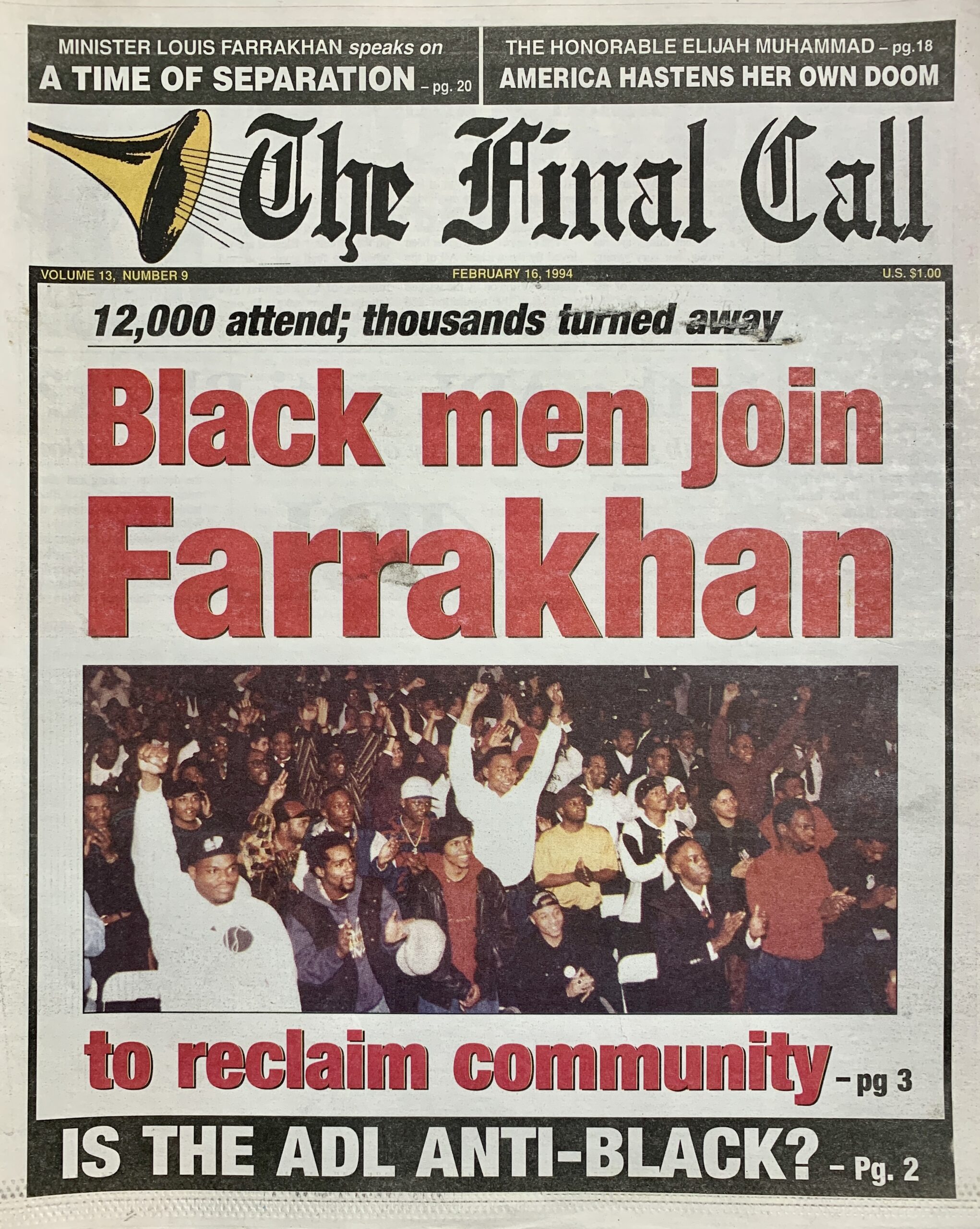
Dr. Cornel West, author, Harvard University professor and professor emeritus at Princeton University, called the march one of the great moments in Black America’s history.
“It was in response to the spiritual, economic, and political war against Black people that targeted Black men in terms of the mass incarceration,” commented Dr. West. “Hardly anybody else was talking about it, at that time,” he added, giving Minister Farrakhan credit. “Now when we look back, we can see the devastation … the destruction … the massive damage done on the spiritual bodies of Black people and particularly the Black men in relation to the New Jim Crow,” Dr. West pointed out. He was talking about the crisis of mass incarceration.
Distinct from many marches prior to the Million Man March, “this march had a strong spiritual center to it in terms of trying to get our self-respect in place, our souls intact,” explained Dr. West.
Dr. West observed that some effects and impacts of the march were in ways social scientists could not measure.
“There was a shift in a lot of brothers behaviors … they went back with a new attitude, a new sense of positive self, thinking for self, working for self, believing in self. These things are significant,” said Dr. West.
By way of critique, however, he said, was not having enough institutional follow through, which he said is a common dynamic with marches. Another dynamic Dr. West said was worth noting was the fact that a Muslim leader made the call. He saw a major shift in the fact that historically it was Christian clergy who led marches. He said historians are going to have to come to terms with the spiritual condition of Black people where bold warriors and change agents in the Black community are coming from the Muslim faith. He named Muhammad Ali, Malcolm X, Minister Farrakhan, and conscious artists like Rakim as examples.
“There really is a significant shift taking place,” said Dr. West. “No Christian minister could have called that march; no secular person could have called that march and over 1.5 (million) Brothers show up.”
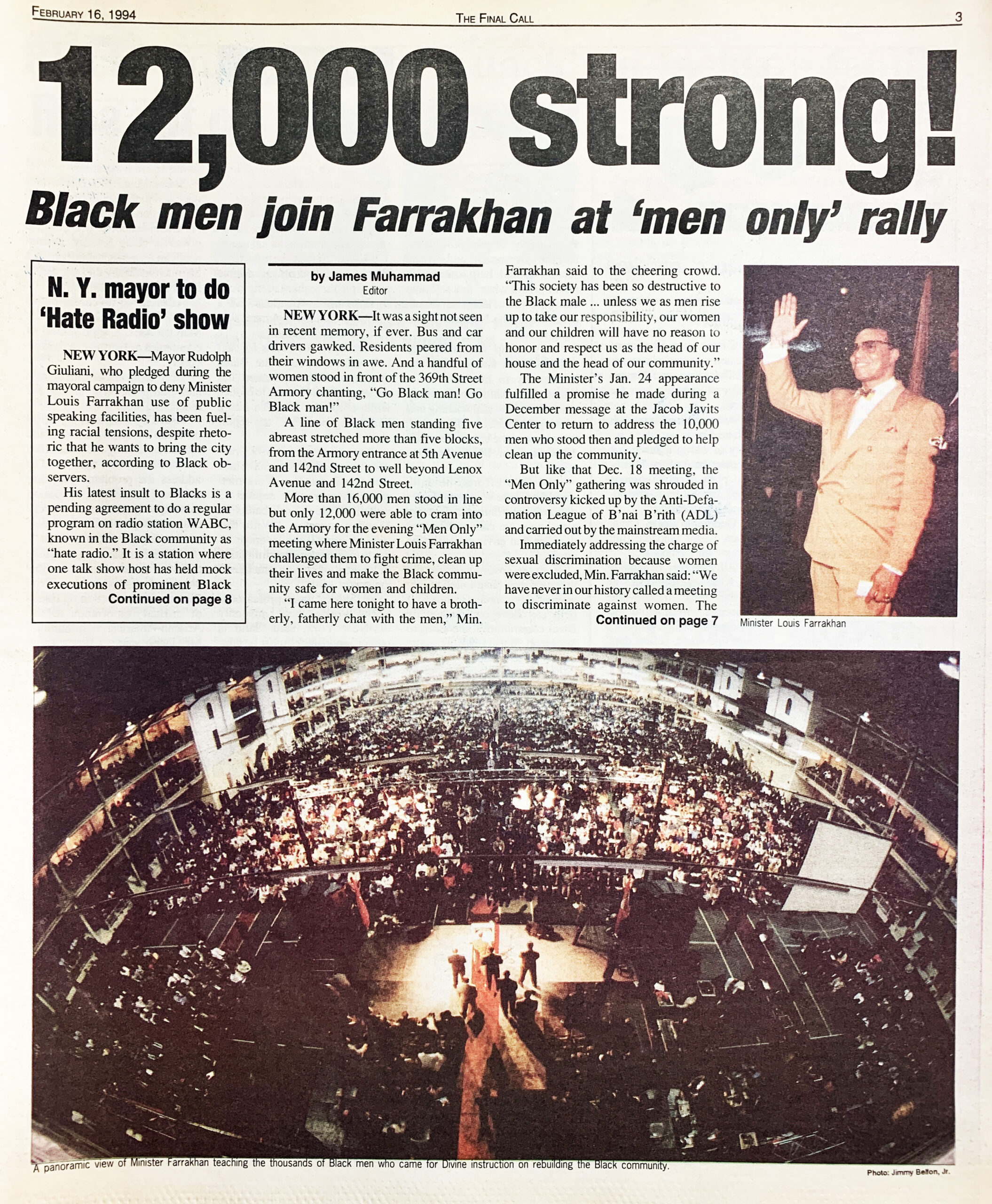
A hallmark of the march from an organizational lens was how the bold vision of Minister Farrakhan, a Muslim, and his ability to galvanize solidarity between Christians, Hebrews, nationalists and many others to work collectively for success.
Part of the beauty of the event was watching the response of Black men who mostly identified as Christians to the call of a Muslim, observed Leonard. F. Muhammad, longtime aide and former Nation of Islam chief of staff. “They saw him as a voice of God and a champion of their hurt,” said Mr. Muhammad.
“The Minister wanted Black men to make a statement regarding atonement, reconciliation and responsibility and wanted us to witness the atonement process, so we can go from 1995 forward and not repeat mistakes we made in our own development and that of our families.”
“He wanted us to know that the resurrection of Black people is first and foremost the responsibility of Black people and nobody is going to do for us what we should do for ourselves,” he said.
Black men were organized and mobilized through local, state, regional and national committees throughout the country.
Veteran radio broadcaster Bob Law, the New York statewide chairperson for the Million Man March, said it was “perhaps the most visionary march of any” that has taken place in this country.
“No march has had the audacity to declare the sacred personhood of Black people,” remarked Mr. Law. “No march.”
Mr. Law said he recently interviewed a minister on his New York City talk show who was calling for a 40 day prayer initiative asking people to turn back to God to deliver America, and was being guided by II Chronicles 7:14, which was also the sacred text that provided the theme for the Million Man March.
“Twenty-five years ago, we said ‘if my people who is called by my name … will humble themselves and pray and turn from their evil ways, then they would hear from heaven and I will heal their land.’ We said that 25 years ago,” he said. “That’s what I meant by it being a visionary march; it was called into existence by a visionary leader.”
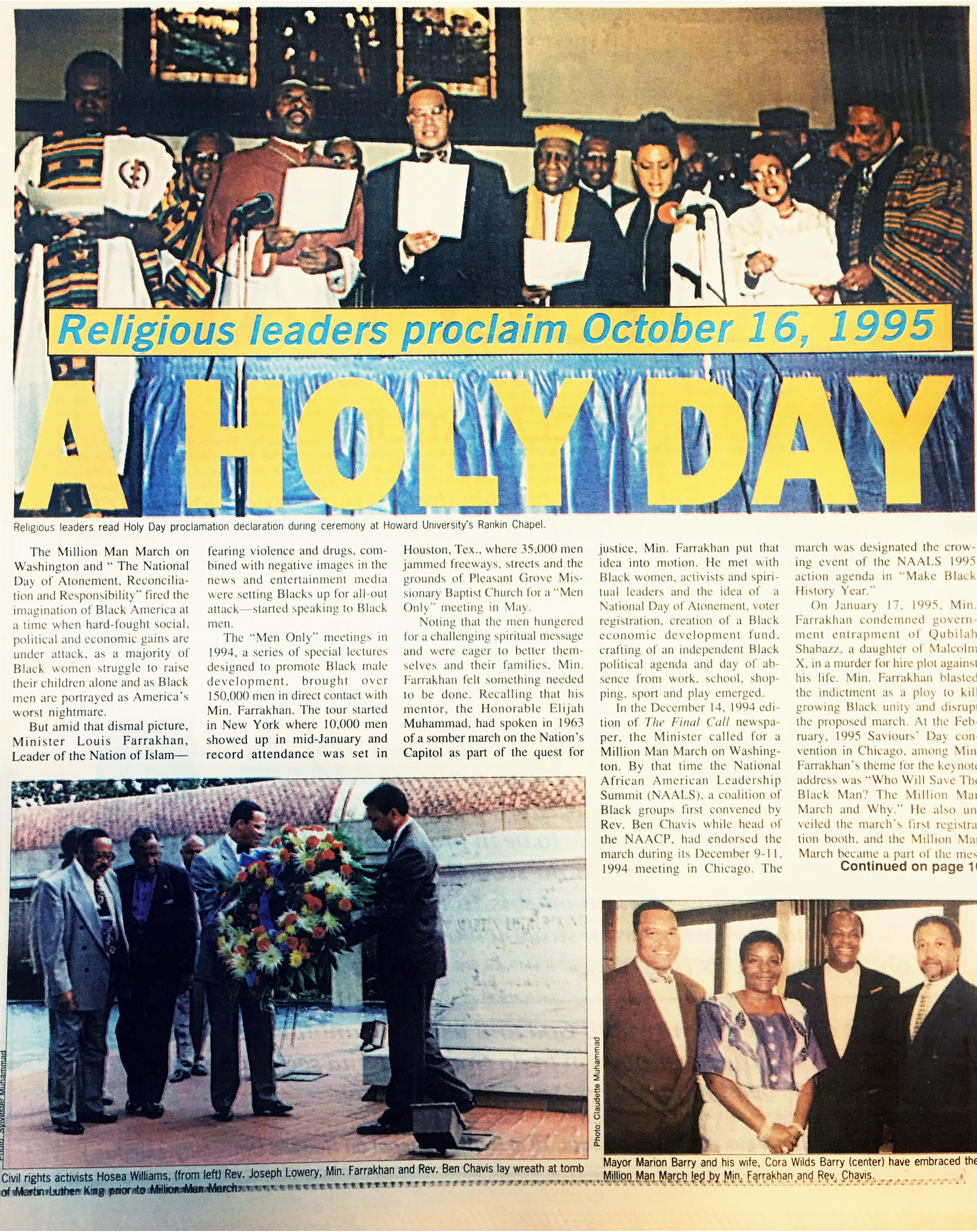
“Twenty-five years later, the principles of the Million Man March are still the most redeeming principles that should be embraced by Black people,” commented Mr. Law. He told the Final Call there needs to be a return to the core values of the March.
Reflecting at a time of the Coronavirus pandemic and discussions about America reopening and people resuming a semblance of pre-pandemic life, Mr. Law said Black people cannot afford to reopen, they have to renew.
“We can’t afford to reopen the community and go back to the social virus that was destroying us before the Biological virus hit,” he said. “The Million Man March … called on Black people, Black men in particular, to renew their commitment, and to renew their minds…therefore to renew the community,” Mr. Law explained.
They came by the plane loads and train loads. Many arrived by buses that lined highways leading to the U.S. Capitol. Organizers in New Jersey brought between 10,000 and 20,000 people through statewide efforts led by state chair Lawrence “Larry” Hamm of New Jersey’s Peoples Organization for Progress and Nation of Islam Minister Abdul Khadir Muhammad, who was assistant state chair and led the Newark mosque. He told The Final Call that LOC’s were established in every major city and 21 counties across the state and attracted the support of pastors, politicians, and major support by women like Fredrica Bey and her group, Women in Support of the Million Man March.
Min. Khadir Muhammad recalled politicians like the late New Jersey Congressman Donald Payne, Sr., then chairman of the Congressional Black Caucus, worked with Washington, D.C. Mayor Marion Barry to help “clear paths” for the success of the New Jersey efforts.
“When Brother Farrakhan called for the march, Allah stepped right in, Master Fard Muhammad and the Most Honorable Elijah Muhammad, putting people that were already in places to help and assist in this great effort,” he said. “The timing was ripe for the state of New Jersey.”
In D.C., the mayor was critical to March success and so was the late Samuel “Sam” Jordan, who was director of the Office of D.C.’s Emergency Preparedness and chairman of the Mayors Special Events Task Force.
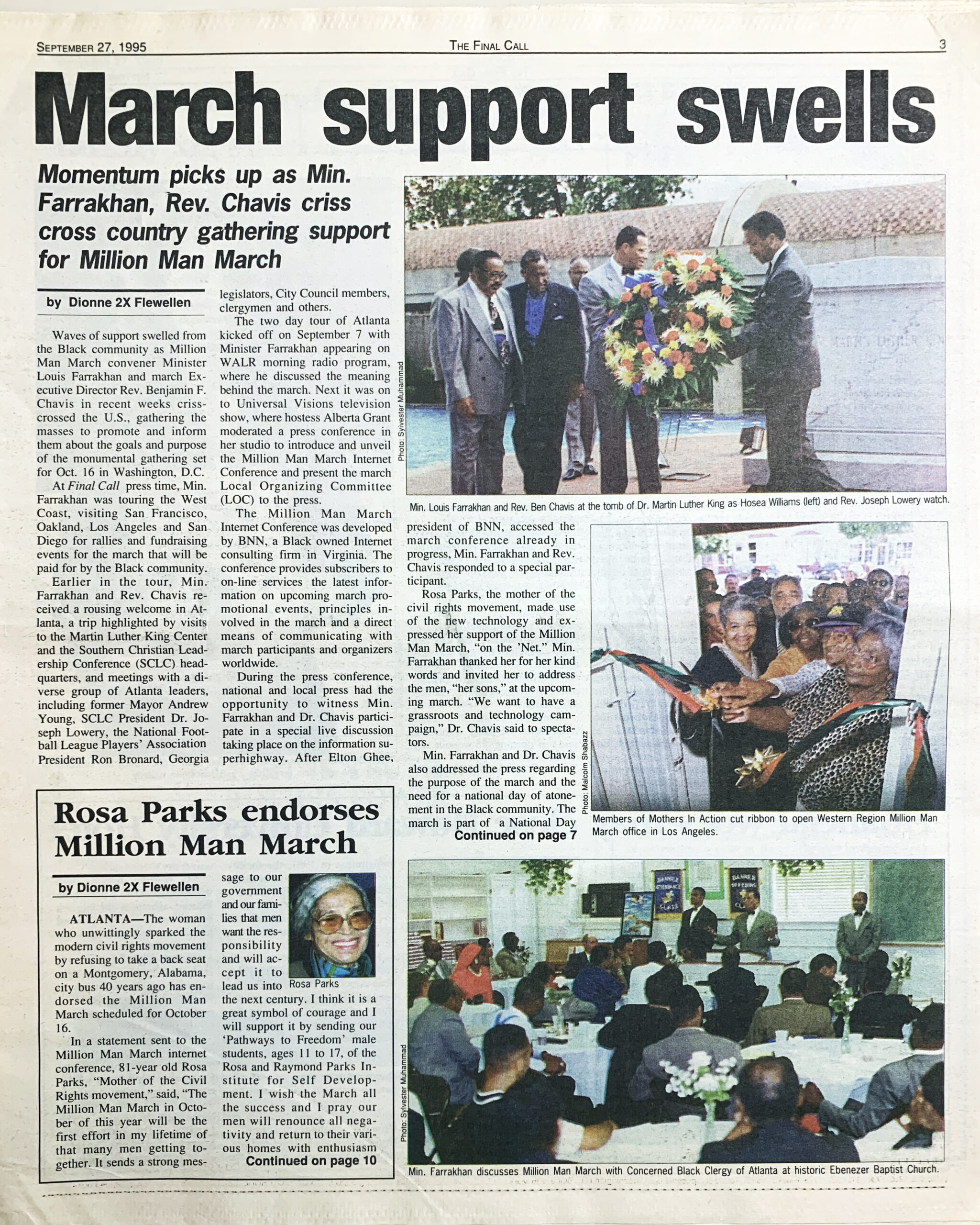
He was key to helping organizers navigate the processes of the federal government and logistics on the ground. “We had to come up with a transportation plan for the march and God blessed us to come up with one, the planning committee approved of and the city and government officials approved of,” said Ernest W. Muhammad, who headed the Transportation Task Force. It was a monumental task with the goal of getting “the buses and people to arrive between 3 a.m. and 5 a.m.”
For Zaheer Ali, who was the assistant to the national director of the March, Dr. Benjamin Chavis, the march holds lessons for today’s activists.
“The Million Man March is something that has to be commemorated because we are a generation away from it and many of today’s activists can learn a lot about the level of organizing and mobilizing that went into one of the largest mass gatherings of Black people in American history,” said Mr. Ali.
Mr. Ali pointed out that the success of the March took “real grassroots organizing” and “word of mouth” in an era before social media and cell phones, when everybody had pagers.
The march involved Black organizations, churches, mosques, temples, fraternities and sororities organizing behind the effort. Black media, newspapers, talk radio, the National Newspaper Publishers Association, and media people like Bev Smith, Bob Law, Cathy Hughes and Bob Johnson, then owner of Black Entertainment Television, which provided one of the earliest major media platforms for promoting the march.
“I think that this demonstrates the significant organizing and mobilizing skills that we have always had in our community and that we should continue to draw on,” said Mr. Ali.
In 1995 and today, there are still two Americas: One Black, one White, separate and unequal.
“The Million Man March was one of the highest moments in the history of our people, and when I say history, I mean the totality of our history even before the period of enslavement because we are descendants of a glorious antiquity that goes back to Africa,” said Mark Thompson, host of the SiriusXM progressive radio talk show, “Make It Plain.”
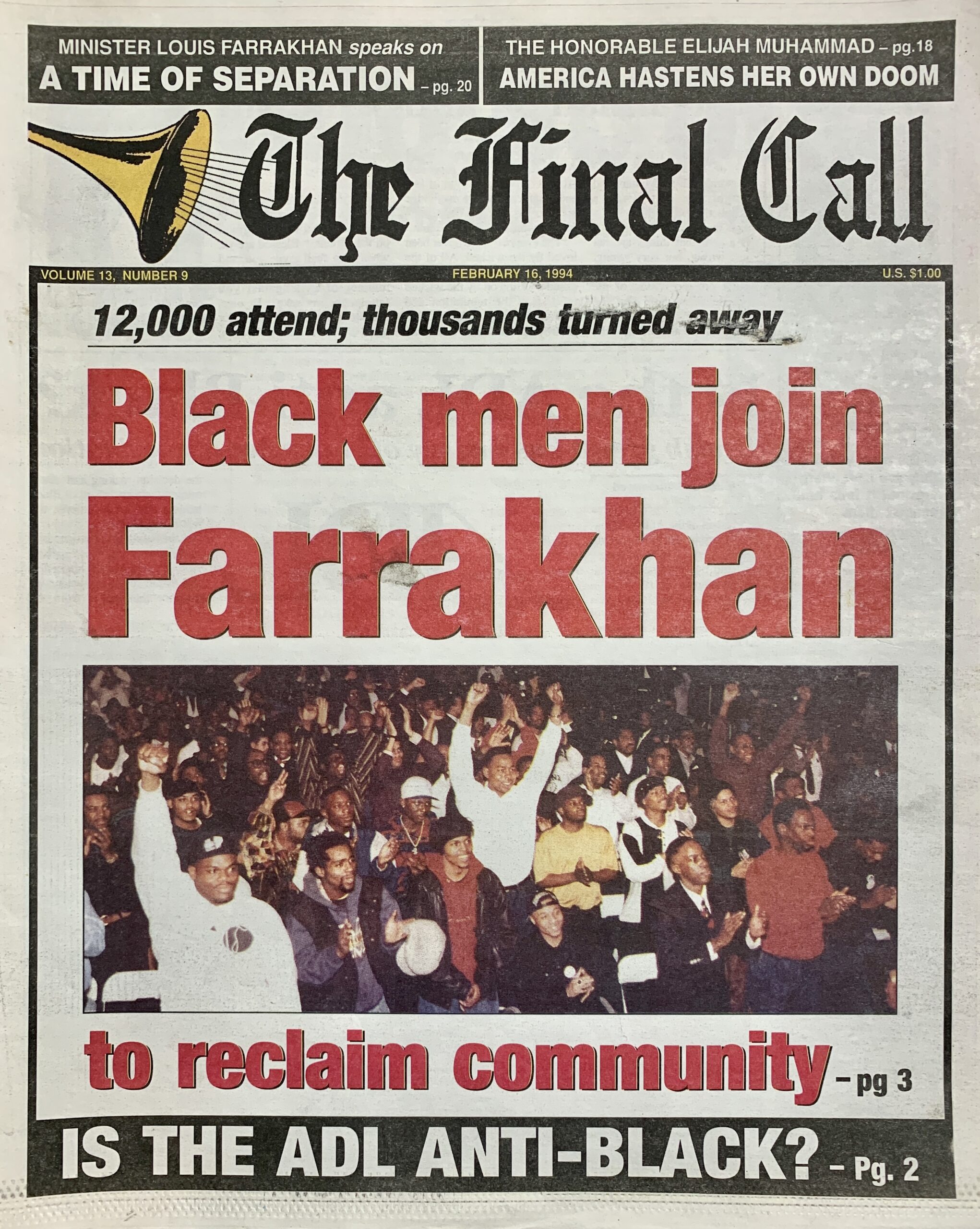
“The Million Man March is a part of that whole continuum of history,” he added.
Mr. Thompson was an emcee at the event and said never on one day, at one time with such a large presence were Black men so elevated and an example before the world.
“Even in the darkest moments we have experienced since the Million Man March, we all can go back and reflect on that day and use that day … to seek and imagine and want to strive for that same higher place of being that we felt on October 16, 1995,” reflected Mr. Thompson.
Besides those who attended, millions more viewed the event live on television and participated in a Day of Absence from work, school and play at part of a Holy Day of Atonement as the March day was declared. It was a day to fast, pray and make peace with one another.
The Million Man March Day of Absence Mission Statement was authored by Dr. Maulana Karenga, professor and chair of Africana Studies at California State University-Long Beach.
In an email to The Final Call, Dr. Karenga said, “The March will always have the meaning we give it. And that will be determined by how we use its principles, policy commitments, and goals in the way we live our lives, do our work, and wage our struggles.”
To achieve this, he added, the closing call of the Million Man March Mission Statement must be kept in mind as it calls Black men and women to stand up and stand together. It says, through historic work and struggle, let us “strive to always know and introduce ourselves to history and humanity as a people who are spiritually and ethically grounded; who speak truth, do justice, respect our ancestors and elders, cherish, support and challenge our children, care for the vulnerable, relate rightfully to the environment, struggle for what is right and resist what is wrong.”
Women played a critical role in the March. A host of women leaders were involved in the planning, success and spoke the day of the March. Women all over the country supported their husbands, sons, fathers, uncles and brothers with hope for a new day for the Black man, his family and community.
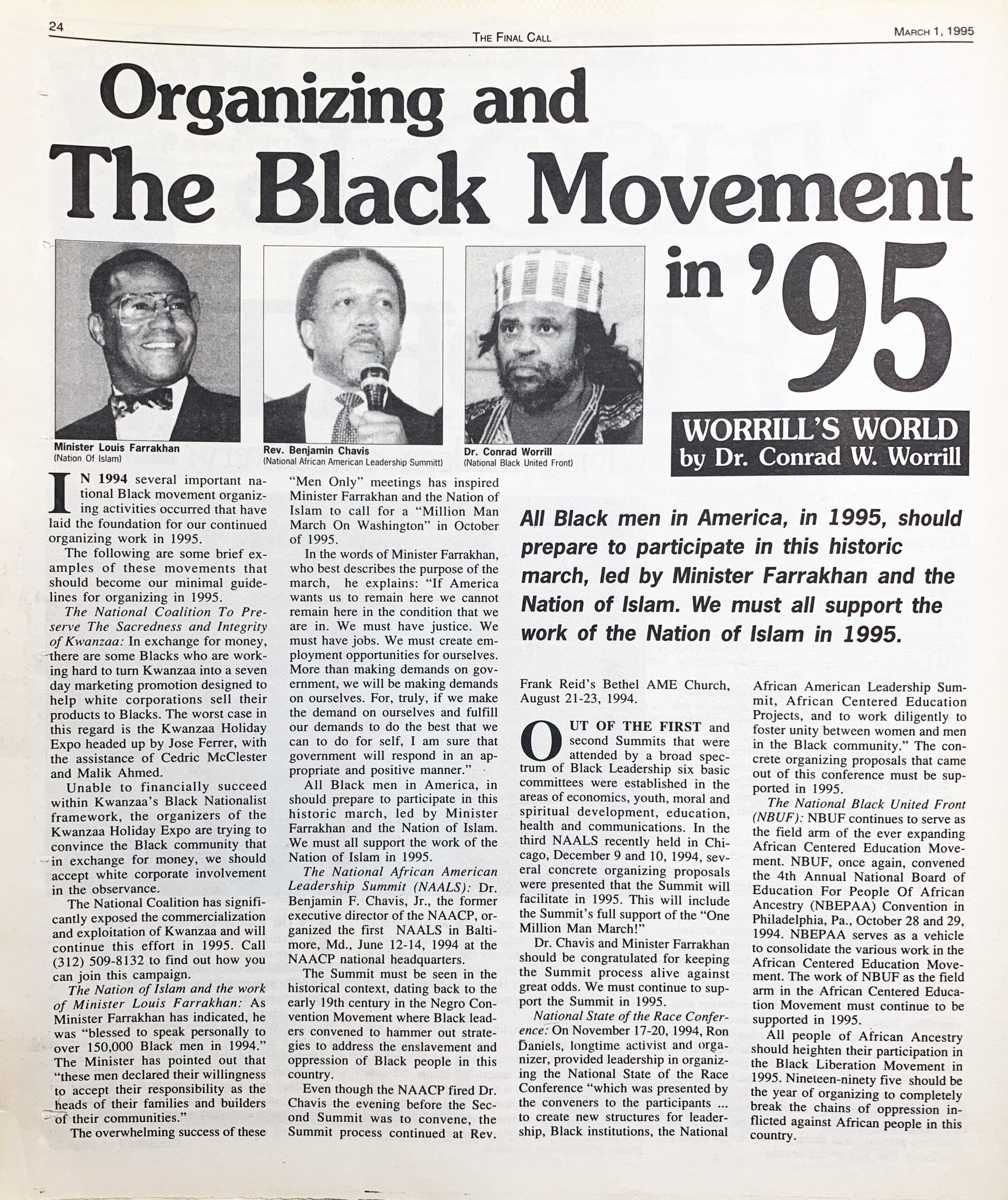
“The sadness is that 25 years later, we need the Honorable Minister Farrakhan back on the street again,” said media veteran Bev Smith, who was instrumental in national media exposure for the March.
“What we had at that point was a strong male presence,” Ms. Smith said in a telephone interview.
In today’s volatile time, Blacks are increasingly vulnerable to racially motivated violence and young Black men are killing each other, she said.
Ms. Smith lamented there is a generation of young Black men who have no idea, the sacrifices paid by Minister Farrakhan and people like Jesse Jackson and Al Sharpton. She was saddened that the legacy of “the victory” as she described the March, was not fully carried on.
There is a void of voices today that didn’t exist 25-years-ago and there is a need for organizing and talking to young Black men and women like the Nation of Islam talks with young women about the role they must play in reestablishing strong Black family, she said.
“The Million Man March did all of that, but more than anything it proved that Black men from all over this country can take a bus, a truck, a plane, a train, and come together in one voice,” said Ms. Smith. “And for me to have witnessed that; that’s a blessing from God.”
“I want another Million Man March,” Ms. Smith said emphatically. “I want these young people to be able to see strong African-American men standing up.” Ms. Smith, who has weathered storms for her dedication to Black uplift and uncompromising relationship to Minister Farrakhan over the years, expressed gratitude for being asked to help with media exposure.
“I loved the fact that the Minister trusted me enough to let me be the voice … the one to put them on the radio and the television so that it could be told the right way,” she said.
Since the two million men gathered, there came the Million Woman March; Million Family March; the Million Youth March, and then the Millions More Movement in a quest to organize and mobilize change. Every October through the “Holy Day of Atonement and Reconciliation” the March purpose is recognized.
The Million Man March has inspired many gatherings of the same name worldwide from parts of the Western Hemisphere to the Middle East and Africa, said Abdul Akbar Muhammad, the International Representative of the Nation of Islam.
“Twenty-five years is really history and they’ve tried to marginalize the impact the March had,” he said. “Out of many marches in America, the Million Man March stood out and impacted other marches around the world,” he added.
He pointed out that naysayers and opposers “underestimated the influence that Minister Farrakhan had among Black people in America and throughout the world.”
Min. Akbar Muhammad recalled the response of leaders worldwide such as the late Libyan leader Muammar Gadhafi, who called Minister Farrakhan after viewing the March in Libya to express his joy and continued solidarity.
After the March, Min. Farrakhan embarked on what was his second World Friendship Tour where he sought to tie the struggle of Black people in the U.S. with Africa and the Muslim world. The Minister continued to spread the message of atonement, reconciliation, peace and responsibility to nations and leaders.
“The international press was present at the march and carried it throughout the world,” said Min. Akbar Muhammad. “So, the word went around the world and increased the Minister’s stature internationally.”
Among the March wins? Roughly 1.7 million Black men registered and voted in the 1996 national election. The NAACP, other organizations, churches and mosques saw membership increases. The National Association of Black Social Workers reported a flood of applications to adopt Black children. Major documents such as “The National Agenda,” a programmatic plan of action and guide for public policy was produced.
Another important development in the 25 years was the introduction of “Nine Ministries.” which are “building blocks of an independent society” and specialized fields to serve the public.
Dr. Benjamin Chavis, who was the March’s national director, pointed to Local Organizing Committees in 150 cities across the country. In an interview earlier this year, he said the March was embraced because the Minister, the call and message were on time.
Minister Farrakhan called the men to gather—not in protest—but to make a commitment to God, self, family and community. The day was themed a Holy Day of atonement, reconciliation and responsibility.
Chicago’s Reverend Al Sampson said it was clear because of his experience working with Dr. Martin Luther King, Jr., he could see what a prophet in the 20th century “looks like, talks like, and acts like” in Minister Farrakhan.
“I found that in Martin Luther King, but I also found it in Minister Louis Farrakhan. He went around letting everybody know… that we had to love one another, put down our weapons and pick up our responsibilities,” said Rev. Sampson.
“It was very clear in his prophesy and all that we are experiencing at this moment in time grew out of wisdom of Minister Louis Farrakhan and his ability to say to the power structure that you need to be responsible for the words that you speak and the actions that you impose on our people,” said Rev. Sampson.
The Minister gave the prophetic call, two million “brothers” came to Washington D.C. “They dismissed the Congress, the president left the White House, and we talked to them—through the drive, integrity and the prophesy of Minister Farrakhan—about our house,” said Rev. Sampson.
“Since the congressional house was empty and the White House was empty, Minister Farrakhan was able to do a deep seated analysis about our house,” he continued. “And because the powers that think they are did not listen, God is now angry at our behavior and God is angry about our relationships on the principles of violence versus nonviolence, economic responsibility and opportunity,” added Reverend Sampson.
“We thank God for Minister Louis Farrakhan for who he is, who he was, and who he will be down through the pages of human history,” the pastor said of his brother and friend.












